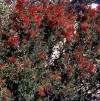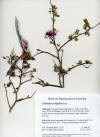|
Calliandra californica |
|
|
Calliandra eriophylla |
Calliandra eriophylla
|
|
Calliandra eriophylla |
|
|
Encarnacion-Dimayuga R., J. Agundez-Espinoza, A. Garcia, G. Delgado, G. M. Molina-Salinas and S. Said-Fernandez. 2006. Two new cassane-type diterpenes from Calliandra californica with antituberculosis and cytotoxic activities. Planta Med. 72(8): 757–761. “From the root of Calliandra californica two new cassane-type diterpenes were isolated and characterized, escobarine A (1) and B (2), which showed promising activities against two Mycobacterium tuberculosis strains. The microplate alamar blue assay was used to determine the minimum inhibitory concentrations (MIC) of 1 and 2 against M. tuberculosis H37Rv and the resistant CIBIN/UMF15 : 099 strains. The MIC of 1 against the resistant M. tuberculosis strain showed a value 8 times lower than that of rifampin. The structures of the bioactive constituents were established by extensive NMR data analyses (including 1D and 2D NMR). The relative configuration of 2 was confirmed by X-ray analysis and the absolute configurations of 1 and 2 were determined by the circular dichroism method. Additionally, 1 and 2 displayed remarkable cytotoxic activity when evaluated against five human tumor cell lines.” Encarnacion R., N. Ochoa, U. Anthoni, C. Christophersen and P. H. Nielsen. 1994. Two new flavones from Calliandra californica. J. Nat. Prod. 57(9): 1307–1309. “Two new flavones were isolated from the medicinal plant Calliandra californica, 7,2',4',5'-tetramethoxyflavone [1] and 5-hydroxy-7,2',4',5'-tetramethoxyflavone [2]. The structures were determined from spectral evidence and both compounds were synthesized. Compound 2 exhibited antimicrobial activity for two test bacterial strains.” Nakamura T., T. Takeda and Y. Ogihara. 1994. Studies on the constituents of Calliandra anomala (Kunth) Macbr. II. Structure elucidation of four acylated triterpenoidal saponins. Chem. Pharm. Bull. (Tokyo) 42(5): 1111–1115. “Four new triterpenoidal saponins, called calliandra saponins B (8), C (9), D (10), and F (12), were isolated from the branches of Calliandra anomala (Kunth) Macbr. The structures of these compounds were established on the basis of NMR spectra, FAB-MS, and the chemical evidence. These saponins, interestingly, have a N-acetyl glucosamine at the 3 position of the genin, and one or two monoterpene glycosides at the position of the sugar chain.” Takeda T., T. Nakamura, S. Takashima, O. Yano and Y. Ogihara. 1993. Studies on the constituents of Calliandra anomala (Kunth) Macbr. I. Structure elucidation of two acylated triterpenoidal saponins. Chem. Pharm. Bull. (Tokyo) 41(12): 2132–2137. “Two novel triterpenoidal saponins, called calliandra saponins A and E, were isolated from the branches of Calliandra anomala (Kunth) Macbr. On the basis of the chemical and physiocochemical evidence, their structures were defined as 3-O-alpha-L-arabinopyranosyl-(1-->2)-alpha-L-arabinopyranosyl++ +-(1-->6)-2- acetamido-2-deoxy-beta-D-glucopyranosyl echinocystic acid 28-O-(beta-D-glucopyranosyl-(1-->3)-[beta-D-xylopyranosyl-(1-->3)-beta-D - xylopyranosyl-(1-->4)]-alpha-L-rhamnopyranosyl-(1-->2)-[(6S)-2-trans- 2,6-dimethyl-6-O-beta-D-xylopyranosyl-2,7-octadienoyl-(1-->6)]-bet a-D- glucopyranosyl) ester (4) and 3-O-alpha-L-arabinopyranosyl-(1-->2)-alpha-L-arabinopyranosyl++ +-(1-->6)-2- acetamido-2-deoxy-beta-D-glucopyranosyl echinocystic acid 28-O-[beta-D-glucopyranosyl-(1-->3)-[beta-D-xylopyranosyl-(1-->3)-beta-D - xylopyranosyl-(1-->4)]-alpha-L-rhamnopyranosyl-(1-->2)-[(6'S)-2'-trans- 2',6'-dimethyl-6'-O-(2-O-(6S)-2-trans-2,6-dimethyl-6-hydroxy-2,7-octa dienoyl)- beta-D-xylopyranosyl-2',7'-octadienoyl-(1-->6)]-beta-D-glucopyr ano syl] ester (5), respectively.” |
|


